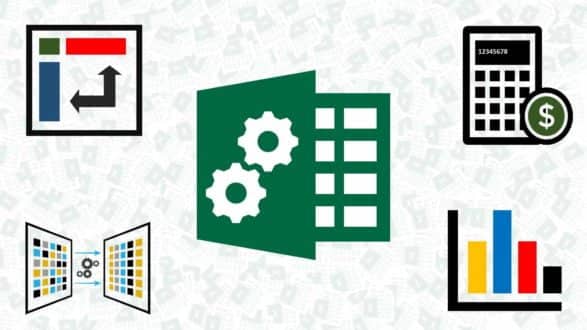Learn Depreciation Accounting with Excel with a Robust Excel Model to derive, forecast, and budget depreciation and Assets using Straight Line Method
Table of Contents
Are you tired of struggling with the complexities of calculating depreciation accounting and budgeting for your business? Do you want to streamline your financial management and have more time to focus on growing your business? Then, look no further than our online course – Learn Depreciation Accounting with Excel!
This comprehensive video course will equip you with the skills and knowledge you need to become a depreciation accounting expert. Our robust Excel model will teach you how to calculate, forecast and budget depreciation and assets using the straight-line method, the most commonly used method in the business world.
Read interesting facts about Depreciation and Accumulated depreciation here.
What is Depreciation and Fixed Asset?
- In accounting terms, depreciation is the reduction of documented cost of a fixed asset in a systematic manner until the value of the asset is written down to zero or negligible.
- Fixed assets include buildings, furniture, office equipment, plant & machinery, etc. The land is the only exception which cannot be depreciated as the value of land appreciates with time.
- Depreciation allows a portion of the cost of a fixed asset to be the revenue generated by the fixed asset.
- This is mandatory under the matching principle, as revenues are recorded with their associated expenses in the accounting period when the asset is used.
- This helps in getting a complete picture of the revenue generation transaction.
What Will You Learn in the Course?
- Hands-on knowledge of how depreciation and fixed assets accounting works
- Fixed assets and depreciation forecasting in Business budgeting
- The impact of the sale of assets prematurely on your profit and loss for the period
- Depreciation Accounting with Excel, since Excel is going to tool for any Accountant or Analyst at most organisations around the globe
Requirements before enrollment to the course
- Essential to Intermediate knowledge of Microsoft Excel
- Critical for Intermediate knowledge of Accounting (Practical Accounting)
- Accounting terms for Fixed Assets and Depreciation (briefly explained in the introduction section of this course)

Why Choose This Course?
- Depreciation Accounting for Fixed assets is a usual activity and process for an accountant. Still, things can get tricky and complicated when there are several assets and transactions like disposal, sale and purchase in mid-month/mid-year.
- This course is designed to help you understand the concept of depreciation through practical situations and examples.
- It is vital to have a robust Fixed assets and depreciation model. It calculates accurate depreciation monthly and helps you budget and forecast depreciation costs for the next year (years to come). Also, when there are assets sale/disposal, you need to figure out the exact profit or loss on such sale/disposal (especially when it takes place on old days in the month/year)
- I will guide you through practical accounting issues and situations while accounting for depreciation, forecasting depreciation costs, and the impact of the sale of assets (profit and loss) on your profit and loss statement and Balance sheet.
- The depreciation model I have prepared for the course is quite robust and takes care of any practical scenario in dealing with situations; you can learn more about the Model here and can download the template only!
- As a Bonus, I cover another critical topic about depreciation: tax benefit or depreciation tax shield; this can be very useful if your country’s taxation laws allow a higher asset depreciation rate.
- This will create a short-term benefit to new businesses and help you grow even if you have invested in Fixed Assets early!
- I will release another course shortly covering other methods of Deprecation (WDV or DB method, DDB Method, SYD Method, Production Units Method) along with each method’s template. This course will also cover Fixed Assets and their organisational control framework.
- At the end of his course, you will have hands-on experience dealing with any challenging depreciation and fixed assets accounting situation and its financial impact (which your manager would want to know accurately). You will also receive a free copy of the template used in the course !! So let’s dive into it!
Who Must Enrol to the course?
- Accountants who want to sharpen their practical accounting Knowledge for Fixed Assets and depreciation Accounting
- Auditors who want to audit effectively for Fixed assets and depreciation for their clients
- Non-Accounting professionals/Entrepreneurs who want to estimate the impact of depreciation on their investment and Profit and Loss over a fixed term (usually assets helpful life)

Enrol in the course here or download the template (Learn More)
Enroll into the Video Course
and Get Template for Free
- Free Setup support for the template for needs
- Discount on future templates release
- Email support. Write to me on: prashant@exactprobi.org
PRO Excel Depreciation Template (Straight Line Method only)
- Free Setup support for the template for needs
- Discount on future templates release
- Email support. Write to me on: prashant@exactprobi.org
You can read awesome testimonials and reviews of the course here
Frequently Asked Questions (FAQs)
The straight-line method of depreciation calculates the depreciation expense of a fixed asset by dividing its cost by its estimated useful life. This method assumes that the asset constantly depreciates over its useful life.
The useful life of an asset is determined based on various factors, such as the nature of the asset, the estimated duration of its use, and the company’s policy. It is important to estimate the useful life of an asset accurately as it affects the depreciation expense charged each year.
Yes, the useful life of an asset can be changed if there is a change in the expected duration of its use. However, any change in the useful life should be supported by proper justification and reflected in the financial statements.
The depreciation expense using the straight-line method is calculated by dividing the cost of the asset by its estimated useful life. The resulting amount is charged as depreciation expense each year until the end of the asset’s useful life.
Depreciation expense reduces the value of the asset on the balance sheet and is reflected as an expense on the income statement. It affects the net income of the company and also impacts the tax liability.
Yes, an asset can be fully depreciated before the end of its useful life if its cost is less than the salvage value. Salvage value is the asset’s estimated value at the end of its useful life.
Depreciation expense is a non-cash expense and does not affect the company’s cash flow. However, it reduces the taxable income, which in turn reduces the tax liability and increases the cash flow.
The straight-line depreciation method is simple and provides a systematic and consistent approach to calculating depreciation expense. It also reflects the asset’s expected useful life and helps determine its actual cost.
The straight-line depreciation method assumes the asset constantly depreciates over its useful life. However, in reality, the asset may depreciate at a faster rate in the initial years and at a slower rate in the later years.

